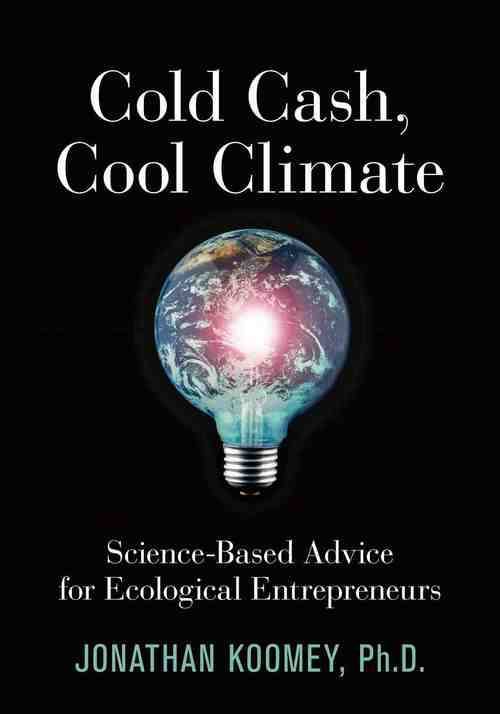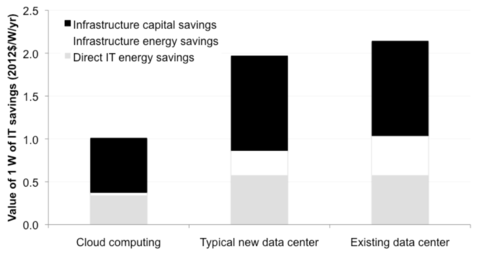This article is an abridged, re-edited, and amended version of an article that recently appeared as Koomey, Jonathan. 2014. “Separating Fact From Fiction: A Challenge For The Media.” In IEEE Consumer Electronics Magazine. January. pp. 9-11.
“It ain’t what you don’t know that gets you into trouble. It’s what you know for sure that just ain’t so.”
–Josh Billings
One of the less endearing features of the information age is the endless proliferation of attention-getting “factoids” that “just ain’t so.” Take, for example, the amount of electricity associated with accessing the Internet through your smart phone. A recent coal industry-funded study [1] claimed that the iPhone uses as much electricity as two refrigerators when you count the energy needed to make it, run it and power the “behind-the-wall” equipment to deliver data to the device. Discussion of the original report (The Cloud Begins with Coal, hereafter CBC, written by Mark P. Mills) showed up on the Breakthrough Institute web site, Time Magazine Online, MSN News, the Huffington Post, MarketWatch, and Grist, among others (with most focusing on the comparison between a smart phone and one refrigerator [2]).
When I heard this claim, it took me back to the year 2000, when Mr. Mills and Peter Huber first made the claim [3] that the networking electricity for a wireless Palm VII exceeded the electricity for running a refrigerator. This claim, and the related ones about the total electricity used by computing and communications, turned out to be bunk, with the electricity used by a wireless Palm VII overestimated by a factor of 2000 [4, 5, 6, 7, 8, 9, 10, 11, 12, 13]. Not surprisingly, the new claim about smart phones and refrigerators also was a gross overestimate of the electricity associated with mobile phones [14, 15].
The danger, of course, is that policy makers and business planners will be misled by such claims, as they surely were last time, and make consequential mistakes [7]. The more important story, however, revolves around the credibility of the source and how the media treat him. If scientists make claims that have been shown repeatedly in the peer-reviewed literature to be incorrect, they would normally retract their results and admit their errors. That’s how science is supposed to work. If they fail to accept these results and continue to make the same misstatements without presenting empirical evidence to support them, they are effectively ostracized from the scientific community and aren’t taken seriously again.
Professional reputation is precious and perishable, and those who violate the scientific code of conduct face intellectual exile. It’s hard to regain your scientific reputation once it’s ruined, but the media world is different. Like Mr. Mills, many people make incorrect statements but continue to get media attention even after their claims have been soundly refuted in the technical literature (Bjorn Lomborg, of Skeptical Environmentalist fame, is another archetypal example). It shouldn’t be that way, of course, but the media continue to fall into this trap.
Why does this keep happening? I can think of at least four reasons.
1) The Newness Filter: Our current fast-paced media world prioritizes “newness” of information, with typical news cycles becoming ever shorter. This bias towards publishing the most recent information as quickly as possible makes it difficult to get attention paid to in-depth refutations, which often take time to produce and detailed articles to present (by the time they are finished, the issue they address is already “old news”). In addition, there’s a structural bias that works in favor of people creating incorrect factoids: It’s much easier and quicker to fabricate factoids that look new, novel, and newsworthy than to debunk them (which often requires significant time, technical training, and careful peer review).
2) The Profit Motive: The pressure on news media to make profits is often antithetical to careful reporting on technical issues. Traditional newspapers have been in a death spiral for years, as the cash cow of classified advertising has been displaced by vastly more efficient online marketplaces, but most other media sources have been under pressure as well. There are few dedicated science reporters nowadays, because training someone on those complex issues isn’t cheap, and media organizations cutting staff left and right just can’t afford that anymore.
Financial constraints also result in constant pressure to increase the number of readers or viewers (in large part to attract well-heeled advertisers), which means that news organizations become beholden (or at least more sympathetic) to the status-quo interests who have the money to advertise. While this may not be a concern for some policy issues, any societal problem that threatens major status quo interests (like climate change) can’t fail to get short shrift when news organizations are so dependent on advertising from those very interests.
3) The Romance with Contrarians: The environmentalist turned skeptic always gets a lot of attention. It’s an old and simple story, and one that in many journalists’ eyes confers credibility on the source. But it’s also an easy storyline to fabricate, and it’s important for anyone reading work by self-proclaimed environmental contrarians to view their credentials and their claims with added skepticism.
4) The Quest for “Balance”: The safest approach for journalists reporting on contentious topics is to stick to what different people say about the issue, writing “He said this, she said that.” But what if there is really a right answer, and people making false and misleading arguments are in the pocket of powerful vested interests? This has happened many times before, with cigarettes, lead, asbestos, and most recently on the climate issue [16]. The public needs someone (presumably journalists) to report when someone makes claims at odds with the current scientific consensus, so citizens can make an informed judgment. Without such information, news stories convey false equivalence between claims that are technically accurate and those that aren’t. That omission creates a bias towards preserving the status quo, one not based on evidence but on a cultural presupposition by journalists that “there are always two sides of a story”.
So most media outlets just don’t report sensibly about technical topics. What can they do to fix this problem?
First, news organizations shouldn’t report on technical issues, no matter how delectable the factoid, unless the reporter and editor really understand the topic and have talked with the relevant experts.
Second, it’s important for journalists to understand that on many technical issues, there really are right and wrong answers, and that the safe and comfortable path (to create “balance”, also known by many outsiders as “he said, she said journalism”) is a one-way ticket to really messing up the story. It may be appropriate for some political debates to report both sides in this way, but the public needs the media to sound the alarm when serial obfuscators are trying to pull the wool over their collective eyes.
Third, new business models for journalism that remove the profit motive may result in more accurate reporting on complicated issues, and these new approaches should be an active area of experimentation by those with the means to do so.
Finally, in this complex technological world, we need more journalists who are trained in technical disciplines. How can we hope to address difficult issues like climate change when many journalists just aren’t able to evaluate technical claims with reliability?
The initial attention paid to Mr. Mills’ retread claims about iPhones and refrigerator electricity use provides a cautionary tale for a society struggling to deal with complex issues like climate change in the 21st century. To face this challenge, we need to alter the way media reporting is conducted on technical issues. Here’s hoping we figure out how to make the necessary changes, and fast. On climate, biotechnology, and many other technical topics, there’s simply no more time to waste.
About the author
Jonathan Koomey is a Research Fellow at the Steyer-Taylor Center for Energy Policy and Finance at Stanford University. He’s the author of Cold Cash, Cool Climate: Science-based Advice for Ecological Entrepreneurs, Turning Numbers into Knowledge: Mastering the Art of Problem Solving, and more than 200 other books, articles, and technical reports. For a fun summary of iPhones vs. fridges smack down, see Adriene Hill’s radio story on NPR’s MarketPlace.
References
1. Mills, Mark P. 2013. The Cloud Begins with Coal: Big Data, Big Networks, Big Infrastructure, and Big Power–An Overview of the Electricity Used by the Global Digital Ecosystem. Digital Power Group. August. [http://www.tech-pundit.com]
2. Koomey, Jonathan. 2013. The Electricity Used by iPhones and Refrigerators, Take Two, August 25, 2013
3. Huber, Peter, and Mark P. Mills. 2000. “Got a Computer? More Power to You.” Wall Street Journal. New York, NY. September 7. p. A26.
4. Kawamoto, Kaoru, Jonathan Koomey, Bruce Nordman, Richard E. Brown, Maryann Piette, Michael Ting, and Alan Meier. 2002. “Electricity Used by Office Equipment and Network Equipment in the U.S." Energy–The International Journal (also LBNL-45917). vol. 27, no. 3. March. pp. 255-269.
5. Koomey, Jonathan G. 2000. Rebuttal to Testimony on ‘Kyoto and the Internet: The Energy Implications of the Digital Economy’. Berkeley, CA: Lawrence Berkeley National Laboratory. LBNL-46509. August.
6. Koomey, Jonathan. 2003. ”Sorry, Wrong Number: Separating Fact from Fiction in the Information Age.“ In IEEE Spectrum. June. pp. 11-12.
7. Koomey, Jonathan. 2008. Turning Numbers into Knowledge: Mastering the Art of Problem Solving. 2nd ed. Oakland, CA: Analytics Press. [http://www.analyticspress.com]
8. Koomey, Jonathan, Kaoru Kawamoto, Bruce Nordman, Mary Ann Piette, and Richard E. Brown. 1999. Initial comments on ‘The Internet Begins with Coal’. Berkeley, CA: Lawrence Berkeley National Laboratory. LBNL-44698. December 9.
9. Koomey, Jonathan, Chris Calwell, Skip Laitner, Jane Thornton, Richard E. Brown, Joe Eto, Carrie Webber, and Cathy Cullicott. 2002. ”Sorry, wrong number: The use and misuse of numerical facts in analysis and media reporting of energy issues.“ In Annual Review of Energy and the Environment 2002. Edited by R. H. Socolow, D. Anderson and J. Harte. Palo Alto, CA: Annual Reviews, Inc. (also LBNL-50499). pp. 119-158.
10. Koomey, Jonathan, Huimin Chong, Woonsien Loh, Bruce Nordman, and Michele Blazek. 2004. ”Network electricity use associated with wireless personal digital assistants.“ The ASCE Journal of Infrastructure Systems (also LBNL-54105). vol. 10, no. 3. September. pp. 131-137.
11. Romm, Joe, Arthur Rosenfeld, and Susan Herrmann. 1999. The Internet Economy and Global Warming. Washington, DC: Center for Energy & Climate Solutions.
12. Romm, Joe. 2002. ”The Internet and the new energy economy.“ Resources, Conservation, and Recycling. vol. 36, no. 3. October. pp. 197-210.
13. Roth, Kurt, Fred Goldstein, and Jonathan Kleinman. 2002. Energy Consumption by Office and Telecommunications Equipment in Commercial Buildings–Volume I: Energy Consumption Baseline. Washington, DC: Prepared by Arthur D. Little for the U.S. Department of Energy. A.D. Little Reference no. 72895-00. January.
14. Koomey, Jonathan. 2013. Wild Claims about Electricity Used by Computers that Just Won’t Die (But Should), August 19, 2013
15. Koomey, Jonathan. 2013. Does Your iPhone Use As Much Electricity As A New Refrigerator? Not Even Close, Climate Progress, 2013
16. Oreskes, Naomi, and Eric M. Conway. 2010. Merchants of Doubt: How a Handful of Scientists Obscured the Truth on Issues from Tobacco Smoke to Global Warming. New York, NY: Bloomsbury Press.





